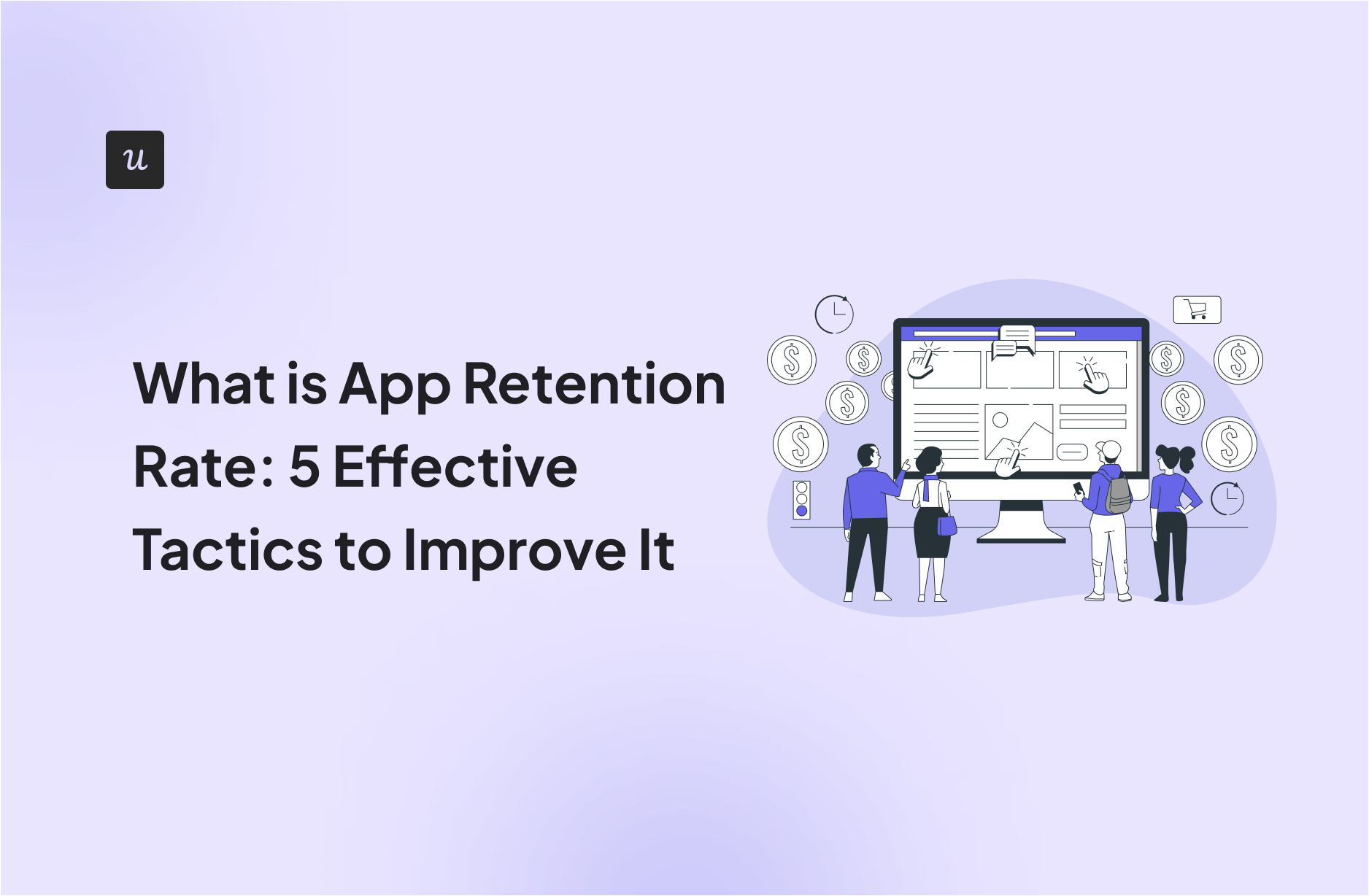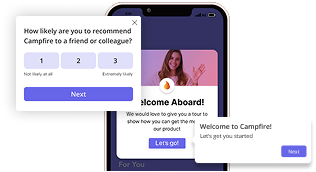
App retention rate is crucial for understanding your app’s long-term success.
If your users aren’t sticking around, no matter how many new ones you acquire, you won’t see the growth you’re hoping for. Improving product adoption goes beyond getting users to install your app: it’s about keeping them engaged.
Tracking your user retention can help you identify pain points in the user journey and pinpoint where you’re losing users.
But how do you measure how many users you’re retaining?
In this article, we’ll look at how to calculate your app retention rate, and the best practical tips to build better user experiences and improve engagement to reduce churn.
Try Userpilot Now
See Why 1,000+ Teams Choose Userpilot

What is app retention rate?
App retention rate is the percentage of users who continue using your app over a specific period. It helps you understand how well your app keeps users engaged.
For instance, if 100 users installed your app and 40 remain active after 30 days, your retention rate is 40%. The higher the retention rate, the more likely your app is to provide value that keeps users returning.
Retention is the opposite of user churn, which measures the percentage of users who stop using your app. If your app has a high churn rate, users are dropping off quickly, indicating potential issues with user experience, onboarding, or long-term value.
For example, if an e-commerce app has a churn rate of 90% within the first month, it suggests users aren’t finding reasons to return after their initial interaction.
Why is tracking app retention rate important?
Tracking your user retention is essential to engage users and reduce churn. You can spot when and where users drop off in their journey by continuously monitoring retention metrics.
For example, you might discover that your onboarding experience causes new users to abandon the app if it’s too long or complex. With this insight, you can adjust your onboarding flow to retain more users.
You can also use retention data to gauge your marketing channels’ effectiveness. For instance, you notice that monthly active users acquired through social media ads stick around longer than those from referral links. You’ll know to invest more in the channel that builds customer loyalty.
Additionally, comparing your mobile app retention rates with industry benchmarks can help you understand whether your app is moving in the right direction. If your retention rate is below average, it may be time to reassess your product or onboarding experience.
How do you calculate app retention rate?
The formula for user retention is:
(Number of users who actively used your app at the end of a given period ÷ Number of users at the start of that period) × 100
However, it’s not as simple as plugging in numbers.
First, define what “actively used” or “engaged” means in your product’s context. For some apps, it might be logging in at least once per week. For an email marketing platform, “engaged” could mean sending at least three campaigns a week since that aligns with the core value proposition of managing email outreach.
Next, decide on the specific period you want to measure. Standard intervals include 7, 14, or 30 days. A project management app might pick a 7-day window to track weekly tasks, while a gaming app might look at 30 days to capture user behavior over longer gaming cycles.
You’ll get an accurate retention rate beyond raw numbers by clearly defining your user engagement criteria and the period. This approach lets you see how often users need to interact with your app to realize its value and helps you target improvements to boost retention.
Mobile app retention benchmarks by industry
During the third quarter of 2024, Android apps had a 20% average retention rate after one day, 5.6% after seven days, and around 2.1% after 30 days from installation. Meanwhile, iOS apps had 23.9% retention after one day and 3.7% after 30 days, generally outperforming Android.
Social media app retention
For Android, social media app retention rose from 1.3% in Q3 2023 to 1.6% in Q3 2024, while iOS went from 2.8% to 3%. This increase suggests that social features and engaging notifications can keep users returning for fresh content.
Fintech apps retention
Fintech apps on Android grew from 3% to 3.1%, while iOS climbed from 6% to 6.6%. Timely updates (e.g., transaction alerts) and secure onboarding flows can encourage users to make your fintech app part of their daily routine.
Gaming apps
Android gaming retention stayed at 1.7%, whereas iOS dipped from 3.8% to 3.6%. Keeping gameplay engaging, through new levels or rewards, may prevent user fatigue and keep sessions frequent.
Lifestyle apps
Android retention dropped from 2.8% to 2.5%; iOS slipped from 2.8% to 2.7%. Introducing personalized recommendations or reminders can revive interest and encourage routine use.
How to improve your app’s retention rate: Our 5 best tips
Practice these tips for retaining users.
Create a smooth onboarding process
A smooth onboarding process gets app users to their “aha” moment quickly and keeps them engaged longer.
Minimize the steps required for sign-up: nobody wants to fill out endless forms before they can explore your app. You can use brief welcome surveys to personalize their onboarding experience and tailor content or features to each user’s needs. For instance, if someone is interested in advanced reporting, you can highlight relevant analytics tools first.
Your messaging should be concise and contextual so newly acquired users understand each feature as they encounter it. A unified onboarding platform—such as Userpilot with features like carousels and slideouts—allows you to introduce new features in small, digestible messages.
Tracking how users move across every touchpoint (like signing up) can help you optimize their onboarding experience.
Use strategic push notifications
Push notifications re-engage users by prompting them to interact with your app. For instance, if someone installs your budgeting app but doesn’t return for a week, send a push notification as a friendly reminder suggesting a quick spending check or a new feature they haven’t explored yet.
Duolingo excels at sending these messages. Its daily language practice reminders motivate users to open the app. If a user becomes inactive, Duolingo sends a “We miss you” note and, if they still don’t return, pauses notifications instead of bombarding them further.
Overusing push notifications can backfire. According to a 2021 study, 39% of users who felt overwhelmed by notifications turned them off completely, and 8% even uninstalled the app. Ensure you keep notifications helpful, personalized, and spaced out, to drive better user retention instead of annoying your users.
Reward loyal and engaged users
Features like daily quests, achievements, or leaderboards encourage behaviors that you want users to repeat. This customer retention strategy is called engagement gamification. It adds an element of fun and friendly competition to your product, making it more engaging for users.
For instance, a product management tool could add badges for tasks completed on time and display a leaderboard that shows team members’ progress. It motivates everyone to keep improving, all while building excitement around routine activities.
Celebrating milestones also makes users feel supported. You could trigger a short animation or offer a small reward when a user completes a new level of training. This positive reinforcement nudges them to continue engaging with your app.
To make gamification even more effective, personalize the experience. For example, tailor quest objectives to each user’s role or interests. To take it further, create engagement loops that encourage repeated participation and let users choose their path, so they always have new challenges to look forward to.
Track and analyze user behavior data
Setting up dashboards to track user behavior data gives you a wholesome view(in one place) of which features are most popular and where users might drop off.
To go deeper, perform cohort analysis—with tools like Userpilot—to compare retention trends across different user segments. Such segments can include those who signed up during the same week or triggered a specific event. This approach helps you see if your product changes, onboarding tweaks, or marketing initiatives are improving mobile app retention over time.
For example, you notice that a cohort of users who joined right after a new product update stick around longer than those who signed up before it. Understanding how each cohort behaves helps you refine your retention strategies, forecast revenue, and predict customer lifetime value.
Regularly collect feedback
Collect feedback to see your app through users’ eyes. This approach involves gathering real-time feedback post-onboarding, after feature interactions, or when users show signs of dropping off. Consequently, you get insights that help you pinpoint where to enhance the user experience.
Some examples of surveys that you can use to collect feedback that helps you improve your app retention rate include:
- Exit surveys: Trigger them in-app when existing users click the “cancel” button to learn why they leave. Offering alternative solutions at this moment can reduce cancellations.
- CSAT surveys: Gauge satisfaction after users interact with a key feature or receive support. Prompt feedback captures fresh reactions and reveals immediate areas for improvement.
- NPS surveys: Ask users—on a scale of 0 to 10—how likely they are to recommend your app. This score helps you track loyalty levels and prioritize follow-ups for detractors.
- CES surveys: Measure how much effort it takes to complete actions, such as finishing onboarding. Lower-effort experiences typically foster higher retention and user satisfaction.
App retention rate FAQs
What is a good retention rate for an app?
A “good” retention rate varies by industry, but anything above 25–30% after 30 days is often healthy. However, context is key. If your app delivers consistent value and shows stable growth over time, even a slightly lower rate might be acceptable for your specific market niche.
Is 70% a good retention rate?
Yes. A 70% retention rate suggests that most of your users keep returning, often reflecting strong onboarding, valuable features, and a solid user experience. Still, focus on continuous improvement. Look at user feedback and analytics to understand what’s working and where you can optimize further.
Is 40% retention rate good?
A 40% retention rate can be good, depending on your app’s category and growth stage. Compare your numbers to relevant benchmarks and track trends over time. A 40% baseline could be a healthy starting point if you’re steadily climbing.
Can the retention rate be over 100%?
Yes, in rare cases. For instance, you begin a period with 100 active users but end with 110 who meet your “active” criteria. Maybe some previously inactive users returned or you changed how you define engagement. That spike can temporarily push mobile app retention above 100%. While it’s a positive sign, it usually reflects a short-term event rather than a long-term trend. Regularly review your criteria and data sources to confirm whether it’s genuine sustained growth or a one-off anomaly.






